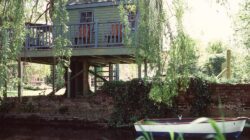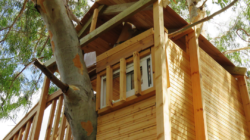Environmental Considerations when Building a Treehouse
Environmental Considerations when Building a Treehouse
Treehouses evoke a sense of wonder and adventure, providing a unique opportunity to connect with nature and enjoy the beauty of the outdoors. However, when building a treehouse, it’s essential to consider the environmental impact and take steps to minimise harm to trees, wildlife, and ecosystems.
- Choose the Right Location: Selecting the right location is the first step in minimising the environmental impact of a treehouse. Choose trees that are healthy, mature, and structurally sound, avoiding those that are diseased, damaged, or at risk of falling. Consider the tree species and their ecological significance, opting for non-invasive attachment methods and minimising damage to roots and branches. Additionally, avoid building in sensitive habitats such as wetlands, riparian zones, or areas with endangered species.
- Use Sustainable Materials: When building a treehouse, opt for sustainable materials that minimise environmental impact and promote resource conservation. Choose responsibly sourced wood products certified by organisations such as the Forest Stewardship Council (FSC), which ensures that forests are managed in an environmentally and socially responsible manner. Consider using reclaimed or salvaged wood for a rustic and eco-friendly aesthetic, or explore alternative materials such as recycled composites or bamboo for added durability and sustainability.
- Minimise Disruption to Trees: Treehouses should be built with care to minimise disruption to trees and their surrounding ecosystems. Avoid drilling into the trunk of a tree, as this can cause damage and compromise its structural integrity. Instead, use non-invasive attachment methods such as suspension systems, brackets, or straps that distribute weight evenly and allow for tree growth. Install protective barriers, such as treehouse attachment bolts (TABs) or treehouse attachment platforms (TAPs), to minimise impact on bark and cambium layers.
- Preserve Natural Habitats: When building a treehouse, it’s essential to preserve natural habitats and minimise disturbance to wildlife. Avoid removing vegetation or altering the landscape unnecessarily, as this can disrupt ecological processes and harm native plants and animals. Leave buffer zones around the treehouse site to protect sensitive habitats and maintain biodiversity. Consider incorporating green roof or living wall features into the design to enhance habitat value and promote ecological connectivity.
- Practice Leave No Trace Principles: Adhering to Leave No Trace principles is essential when building and using treehouses in natural environments. Pack out all construction materials, tools, and waste, leaving the site cleaner than you found it. Minimise noise and disturbance during construction to avoid impacting wildlife and neighbouring properties. Use biodegradable or eco-friendly cleaning products and avoid introducing invasive species or contaminants that could harm native ecosystems.
- Promote Environmental Education and Awareness: Treehouses offer unique opportunities for environmental education and awareness, providing a platform for learning about ecology, conservation, and sustainable living. Consider incorporating educational elements into the design, such as interpretive signs, nature observation decks, or interactive exhibits that highlight local flora and fauna. Engage visitors and guests in environmental stewardship activities such as tree planting, habitat restoration, or wildlife monitoring to foster a deeper connection to nature and inspire positive action.
Building a treehouse presents a unique opportunity to create a sustainable and eco-friendly retreat amidst the trees. By choosing the right location, using sustainable materials, minimising disruption to trees, preserving natural habitats, practicing Leave No Trace principles, and promoting environmental education and awareness, individuals can minimise the environmental impact of treehouse construction and create a sanctuary that celebrates the beauty and diversity of the natural world. Embracing these environmental considerations ensures that treehouses not only provide a magical escape but also contribute to the conservation and preservation of our planet’s precious ecosystems. Contact Us if you have any queries or questions in relation to this article.



